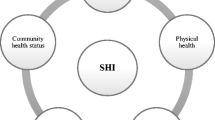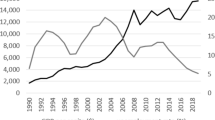Abstract
This paper provides an approach to measure the quality of life in the European Union from a multiple perspective: individual, socioeconomic and territorial by creating a subjective synthetic quality of life indicator, adopting an econometric approach. Amongst other objectives, the works seeks to obtain a robust synthetic measure of quality of life levels using the P2 distance method in addition to conducting an econometric analysis using the European quality of life survey at the individual level. The index comprises information on different social indicators from various life domains and provides a classification of European Union countries. Other objectives the paper pursues include exploring the determinants of the quality of life and ascertaining whether gender differences exist in the levels of quality of life in the European Union. Conclusions may thus be drawn concerning which aspects emerge as the most relevant when explaining disparities in quality of life in the European context from a spatial and gender perspective. The presence of significant gender gaps in many EU countries should lead us to rethink the design of policies aimed at achieving equality for EU citizens. The article also studies the suitability of certain indicators and the estimation problems that arise at the inferential level in a specific context such as the EU.

Source: Own



Similar content being viewed by others
Notes
The job satisfaction variable is not incorporated so as not to restrict the population study to workers.
As explained in the methodology, an iterative algorithm is used to solve this issue and to determine the weights of each variable.
References
Bound, J. (2017). Self-reported versus objective measures of health in retirement models. Journal of Human Resources, 26(1), 106–138. Available at: http://www.jstor.org/stable/145718 Models Self-Reported versus Objective.
Campbell, A., & Converse, P. (Eds.). (1972). Human meaning of social change. The Russell Sage Foundation. Available at: http://www.jstor.org/stable/10.7758/9781610441025.
Crimmins, E. M., Kim, J. K., & Solé-Auró, A. (2011). Gender differences in health: results from SHARE, ELSA and HRS. European Journal of Public Health, 21(1), 81–91.
Deutsch, J. & Silber, J. (2005). Measuring multidimensional poverty: An empirical comparison of various approaches. Review of Income and Wealth, 51(1), 145–174. Available at: http://doi.wiley.com/10.1111/j.1475-4991.2005.00148.x. Accessed 23 Oct 2017.
Esping-Andersen, G. (1990). The three political economies of the welfare state. International Journal of Sociology, 20, 92–123. Available at: https://www.jstor.org/stable/20630041. Accessed 9 Nov 2017.
Eurofound. (2013a). Third European quality of life survey—quality of life in Europe: Families in the economic crisis, Publications Office of the European Union.
Eurofound. (2013b). Third European quality of life survey—quality of life in Europe: Subjective well-being Publicatio., Luxembourg.
Eurostat. (2016). Smarter, greener, more inclusive? INDICATORS TO SUPPORT THE EUROPE 2020 STRATEGY, Luxembourg.
Eurostat. (2017). Final report of the expert group on quality of life indicators. Available at: http://ec.europa.eu/eurostat/documents/7870049/7960327/KS-FT-17-004-EN-N.pdf/f29171db-e1a9-4af6-9e96-730e7e11e02f. Accessed 27 Nov 2017.
Ferrer-i-Carbonell, A. & Frijters, P. (2004). How important is methodology for the estimates of the determinants of happiness?*. The Economic Journal, 114(497), 641–659. Available at: http://doi.wiley.com/10.1111/j.1468-0297.2004.00235.x. Accessed 7 Nov 2017.
García, E. C., Martín, J. A. R., & Pabsdorf, M. N. (2010). The features of development in the pacific countries of the African, Caribbean and Pacific Group. Social Indicators Research, 99(3), 469–485.
González, E., Cárcaba, A., & Ventura, J. (2016). Weight constrained DEA measurement of the quality of life in Spanish municipalities in 2011. Social Indicators Research. https://doi.org/10.1007/s11205-016-1426-y.
Jovanović, V. et al. (2017). Gender differences in the relationship between domain-specific and general life satisfaction: A study in Iran and Serbia. Applied Research in Quality of Life, 12(1), 185–204. Available at: http://link.springer.com/10.1007/s11482-016-9461-z. Accessed 28 Nov 2017.
Khan, H. T. A. & Flynn, M. (2016). Self-reported health status of older adults in Malaysia and Singapore: Evidence from the 2007 global ageing survey. Applied Research in Quality of Life, 11(3), 687–705. Available at: http://link.springer.com/10.1007/s11482-015-9390-2. Accessed 28 Nov 2017.
Martín, J. A. R., del Mar Holgado Molina, M., & Fernández, J. A. S. (2013). An index of progress towards the MDG1 in Southern Africa and the Horn of Africa. Applied Research in Quality of Life, 8(4), 467–480.
Martín, J. A. R., del Mar Holgado Molina, M., & Fernández, J. A. S. (2015). An index of economic and social development in a group of countries in Africa. Applied Research in Quality of Life, 10(3), 495–508.
Mirghafourvand, M. et al. (2016). Predictors of health-related quality of life in Iranian Women of Reproductive Age. Applied Research in Quality of Life, 11(3), 723–737. Available at: http://link.springer.com/10.1007/s11482-015-9392-0. Accessed 28 Nov 2017.
Murray, C. J. L., Salomon, J., & Mathers, C. (2000). A critical examination of summery measures of population health. Bulletin of the World Health Organisation, 78(8), 981–994.
Or, Z. (2000). Determinants of health outcomes in industrialised countries: A pooled, cross-country, time-series analysis. OECD Economic Studies, 30, 53–77.
Oswald, A. J. (1997) Happiness and economic performance. Available at: https://www.andrewoswald.com/docs/happecperf.pdf. Accessed 14 Mar, 2018.
Clark, A. E. & Oswald, A. J. (1996). Satisfaction and comparison income. Journal of Public Economics, 61(3), 359–381. Available at: http://www.sciencedirect.com/science/article/pii/0047272795015647. Accessed 7 Nov 2017.
Pena, B. (1977). Problemas de la medición del bienestar y conceptos afines: (una aplicación al caso español). Madrid: Instituto Nacional de Estadística.
Ray, S. (2014). An index of maternal and child healthcare status in India: Measuring inter- and intra-state variations from capability perspectives. Social Indicators Research, 117(1), 195–207.
Reidpath, D. D., & Allotey, P. (2003). Infant mortality rate as an indicator of population health. Journal of Epidemiology and Community Health, 57(5), 344–6. Available at: http://www.ncbi.nlm.nih.gov/pubmed/12700217. Accessed 6 Nov 2017.
Reidpath, D. D., & Allotey, P. (2007). Measuring global health inequity. International Journal for Equity in Health, 6(February), 16.
Somarriba, N., & Pena, B. (2009). Synthetic indicators of quality of life in Europe. Social Indicators Research, 94(1), 115–133.
Somarriba Arechavala, N., & Zarzosa Espina, P. (2016). Quality of life in Latin America: A proposal for a synthetic indicator. In G. Tonon (Ed.), Indicators of quality of life in Latin America (pp. 19–56). Cham: Springer International Publishing. https://doi.org/10.1007/978-3-319-28842-0_2.
Somarriba Arechavala, N., Zarzosa Espina, P., & Pena Trapero, B. (2015). The economic crisis and its effects on the quality of life in the European Union. Social Indicators Research, 120(2), 323–343.
van Praag, B. M. S. (1991) Ordinal and cardinal utility: An integration of the two dimensions of the welfare concept. Journal of Econometrics, 50(1–2), 69–89. Available at: https://www.sciencedirect.com/science/article/pii/030440769190090Z. Accessed 14 Mar 2018.
Van Praaga, B. M. S., Frijters, P., & Ferrer-i-Carbonell, A. (2003). The anatomy of subjective well-being. Journal of Economic Behavior and Organization, 51(1), 29–49. Available at: http://www.sciencedirect.com/science/article/pii/S0167268102001403. Accessed 7 Nov 2017.
Veenhoven, R. (1999). Quality-of-life in individualistic society. A comparison of 43 nations in the early 1990’s. Social Indicators Research, 48, 157–186. Available at: https://personal.eur.nl/veenhoven/Pub1990s/99a-full.pdf. Accessed 14 Mar 2018.
Whelan, C. T., & Maître, B. (2010). Welfare regime and social class variation in poverty and economic vulnerability in Europe: An analysis of EU-SILC. Journal of European Social Policy, 20(4), 316–332. https://doi.org/10.1177/0958928710374378.
White, H. (1980). A heteroskedasticity-consistent covariance matrix estimator and a direct test for heteroskedasticity. Econometrica, 48(4), 817.
Zarzosa Espina, P., & Somarriba Arechavala, N. (2013). An assessment of social welfare in Spain: Territorial analysis using a synthetic welfare indicator. Social Indicators Research, 111(1), 1–23. Available at: http://link.springer.com/10.1007/s11205-012-0005-0. Accessed 9 Nov 2017.
Acknowledgements
We gratefully acknowledge financial support from the Spanish Ministry of Economics and Competitiveness (FEM2013-43393-P). We would like to dedicate this work to Professor Bernado Pena with the affection of his disciples, Pilar y Noelia.
Author information
Authors and Affiliations
Corresponding author
Rights and permissions
About this article
Cite this article
Somarriba Arechavala, N., Zarzosa Espina, P. Quality of Life in the European Union: An Econometric Analysis from a Gender Perspective. Soc Indic Res 142, 179–200 (2019). https://doi.org/10.1007/s11205-018-1913-4
Accepted:
Published:
Issue Date:
DOI: https://doi.org/10.1007/s11205-018-1913-4




